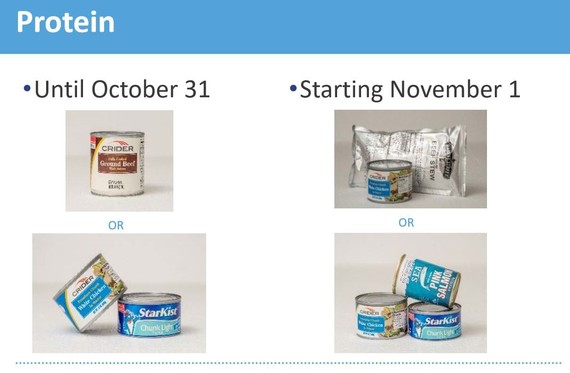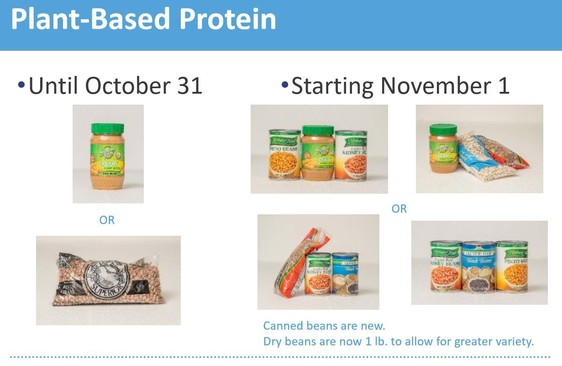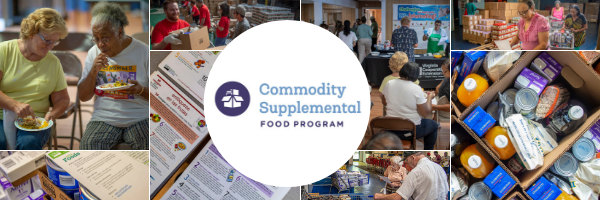Featured Food: Lentils
|
The plant-based protein category will soon be expanding with new, easy-to-prepare options. In addition to canned beans (featured in our May special edition e-letter), dry lentils are an exciting new food that will be available in CSFP.
Lentils are a nutritious protein item packed with fiber, B vitamins, iron, magnesium, zinc, and potassium. They are also easy to prepare as they do not require soaking and can be fully cooked in less than 30 minutes. We encourage you to try this new option and check out the lentil recipes available on What’s Cooking.
|
|
|
Nutrition and the enhanced CSFP Food Package: Focus on Protein
|
Last month we highlighted the nutrition benefits of the Fruit Food Group and the changes made to the CSFP Food Package that will now offer more flexibility to issue different combinations of fruit, juice, and raisins. This month, we will review the Protein Food Group in the enhanced CSFP Food Package. This article will review the nutrition benefits of eating these foods and how the enhanced CSFP Food Package better aligns with MyPlate recommendations.
MyPlate recommendations are based on the 2015-2020 Dietary Guidelines for Americans. According to MyPlate, “All foods made from meat, poultry, seafood, beans and peas, eggs, processed soy products, nuts, and seeds are considered part of the Protein Foods Group. Beans and peas are also part of the Vegetable Group.”
The enhanced CSFP monthly food package divides protein into two categories:
- Meat, Poultry, and Fish Category – An additional unit will be offered which increases the quantity and variety of shelf-stable meat, poultry, and fish offerings.
- Plant-Based Protein – Canned beans and dried lentils will be added as options and the package sizes of dried beans and peanut butter will be reduced to increase food package variety.
We encourage CSFP providers to make a variety of protein options available for participants each month.
|
 
|
Here are some benefits of eating foods from the Protein Food Group:
- Protein functions as a building block for skin, muscles, cartilage, bones, and blood.
- Protein has B vitamins (niacin, thiamin, riboflavin, and B6) which help to build tissues, form red blood cells, and regulate your metabolism.
- Meat, poultry, fish, beans and peas, eggs, nuts, and seeds contain iron and zinc. Iron is used to carry oxygen to the blood and zinc is necessary to maintain a healthy immune system.
- Plant-based proteins are lower in saturated fat and can be used in place of meat in many recipes.
The MyPlate website offers a lot of information. We invite you to visit ChooseMyPlate.gov for more guidance. It is important to remember that MyPlate recommendations are not written for individuals with chronic disease conditions. Those individuals should follow the advice of their medical provider or a Registered Dietitian who is familiar with their health status.
|
Nutrition Updates
Sodium and the CSFP Food Package
The enhanced CSFP Food Package will be introduced in November 2019 and there has been a lot of talk about the nutrition benefits for seniors. So, why aren’t you hearing more about sodium? The improvements recommended for the CSFP Food Package did not focus on sodium because sodium reduction has been a priority for USDA Foods for over a decade! Let’s share some of the highlights of the sodium reduction efforts in CSFP over the years.
All of the canned vegetables seniors receive through CSFP are either low sodium or no salt added. This same low sodium standard will apply to the new vegetable soup option and the canned beans. USDA has also worked with industry to develop lower sodium formulations for other foods, including cheese and beef stew. FNS is also actively working on changes to the chili formulation to transition to a lower sodium formulation. We know how important low sodium foods are for seniors with heart disease or high blood pressure and USDA Foods has made efforts to provide nutritious items to support a variety of different diets. If you have other questions or feedback about the foods available in CSFP, email us at USDAFoods@usda.gov.
CSFP Sharing Gallery: Supporting Nutrition Education Resource Sharing

To support programs in carrying out nutrition education with CSFP participants, USDA recently launched the CSFP Sharing Gallery! The Sharing Gallery is a public website that includes handouts, recipes, lesson plans, and other resources to support local level nutrition education efforts for seniors.
While USDA previously hosted a Nutrition Education Resource page, the sharing gallery is different in that it offers States and local programs the opportunity to submit resources to share with other program sites across the country.
If you have nutrition education resources or recipes to share, please review our inclusion criteria and recipe criteria first, then send appropriate materials to USDAFoods@usda.gov. USDA will review and post new resources to the site on a regular basis.
Webinar Roundup
|
The CSFP Food Package webinar series contains resources to help stakeholders transition to the enhanced CSFP Food Package. The first four CSFP Food Package webinars have been recorded and are available on our website on the CSFP Food Package Toolkit page. Be sure to check out the recorded webinars, including our newest webinar, described below. Look out for information about our CSFP Food Package webinar that will be held in September!
Webinar Recording Available
If you missed the latest CSFP Food Package webinar on July 11, 2019, do not fear, the recording is now available!
Title: Planning for Successful Implementation of the Enhanced CSFP Food Package
Description: In February 2019, USDA announced changes to the monthly food package that will be implemented beginning November 1, 2019. This webinar will focus on the new options and flexibilities within each category and provide guidance about how to plan for a successful transition. To help States and local sites adjust their inventory and orders to implement the changes on November 1, USDA will provide a demo of the recently released Food Package Ordering Tool.
Click here to listen!
|
Planning Tips for July
As you prepare to implement the enhancements to the CSFP Food Package on November 1, USDA has developed a planning calendar as a roadmap to help you break tasks into smaller pieces and work through them in a more manageable way.
- Check your inventories of items that are transitioning to new sizes. Review and adjust your plans to distribute these as soon as possible after November 1 so that you can transition as quickly as possible to the new items.
- Do you have written materials or systems that you use to track inventory, or place orders? Be sure to update these materials prior to implementation.
- Think about how and when to communicate with clients and staff about the upcoming changes to the food package.
-
- Review the sample handouts summarizing key changes for clients and for staff and volunteers. Do you have additional information that you would like to communicate?
- Consider providing information about the changes to staff/volunteers in August and participants in September. Plan to remind both groups again in October.
Ordering To-Do
- Direct ship sites: Confirm that all direct ship orders have been properly consolidated and approved for solicitation.
|